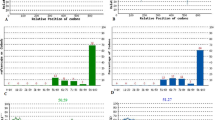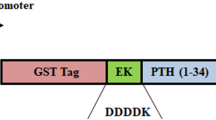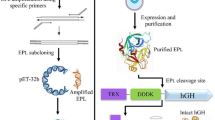Abstract
A novel approach for the preparation of recombinant human glucagon was described. An expression vector pAGluT, containing phoA promoter, phoA signal peptide and glucagon gene, was constructed by means of genetic engineering.Escherichia coli strain YK537 was transformed with pAGluT. High-level secretory expression of recombinant human glucagon was achieved. The expression yield of recombinant human glucagon was found to be 80 mg/L, approximately 30% of the total proteins in supernatant. The biological activities and the physicochemical properties of the purified recombinant human glucagon were found to be the same as that of native glucagon. In addition, our results suggested that phoA expression system may be suitable for the expression of other small peptides.
Similar content being viewed by others
References
Pollack, C. V. Jr., Utility of glucagon in the emergency department, J. Emerg. Med., 1993, 11(2): 195–205.
Hall-Boyer, K., Zaloga, G. P., Chernow, B., Glucagon: hormone or therapeutic agent? Crit. Care Med., 1984, 12(7): 584–589.
Unger, R. H., Role of glucagon in the pathogenesis of diabetes: the status of the controversy, Metabolism, 1978, 27(11): 1691–1709.
Unger, R. H., Orci, L., The essential role of glucagon in the pathogenesis of diabetes mellitus, Lancet, 1975, 1(7897): 14–16.
Unson, C. G., Merrifield, R. B., Identification of an essential serine residue in glucagon: Implication for an active site triad, Proc. Natl. Acad. Sci. USA, 1994, 91(2): 454–458.
Unson, C. G., Gurzenda, E. M., Iwasa, K. et al., Glucagon antagonists: Contribution to binding and activity of the amino-terminal sequencel-5, position 12, and the putative a-helical segment 19–27, J. Biol. Chem., 1989, 264(2): 789–794.
Unson, C. G., Wu, C. R., Fitzpatrick, K. J. et al., Multiple-site replacement analogs of glucagon, A molecular basis for antagonist design, J. Biol. Chem., 1994, 269(17): 12548–12551.
Azizeh, B. Y., Ahn, J. M., Caspari, R. et al., The role of phenylalanine at position 6 in glucagon’s mechanism of biological action: Multiple replacement analogues of glucagon, J. Med. Chem., 1997, 40(16): 2555–2562.
Sturm, N. S., Lin, Y., Burley, S. K. et al., Structure-function studies on positions 17,18 and 21 replacement analogues of glucagon: The importance of charged residues and salt bridges in glucagon biological activity, J. Med. Chem., 1998, 41(15): 2693–2700.
Unson, C. G., Wu, C. R., Cheung, C. P. et al., Positively charged residues at positions 12,17, and 18 of glucagon ensure maximum biological potency, J. Biol. Chem., 1998, 273(17): 10308–10312.
Ishizaki, J., Tamaki, M., Shin, M. et al., Production of recombinant human glucagon in the form of a fusion protein in.Escherichia coli; recovery of glucagon by sequence-specific digestion, Appl. Microbiol. Biotechnol., 1992, 36(4): 483–486.
Kim, D. Y., Shin, N. K., Chang, S. G. et al., Production of recombinant human glucagon inEscherichia coli by a novel fusion protein approach, Biotechnol. Tech., 1996, 10: 669–672.
Shin, C. S., Hong, M. S., Kim, D. Y. et al., Growth-associated synthesis of recombinant human glucagon and human growth hormone in high-cell-density culturesof Escherichia coli, Appl. Microbiol. Biotechnol., 1998, 49(4): 364–370.
Moody, A. J., Norris, F., Norris, K. et al., The secretion of glucagon by transformed yeast strains, FEBS Lett., 1987, 212(2): 302–306.
Judd, R. C., Electrophoresis of peptides, in Basic protein and peptide protocols (des. Walker, J. M.), New Jersey: Humana Press, 1994, 49–57.
Gu, J. L., Zhang, X. T., Labelling of insulin and deshexapeptide insulin with radioactive iodine utilizing a solid phase oxidizer-1,3,4,6 tetrachloro-3α, 6α-diphenylglycoluril, Acta. Biochim. Biophys. Sin. (in Chinese), 1986, 18(3): 277–283.
Cuatrecasas, P., Isolation of the insulin receptor of liver and fat-cell membranes (detergent-solubilized/[1251] insulin-polyethylene glycol precipitation/sephadex), Proc. Natl. Acad. Sci. USA, 1972, 69(2): 318–322.
Von Heijne, G., Analysis of the distribution of charged residues in the N-terminal region of signal sequences: Implications for protein export in prokaryotic and eukaryotic cells, EMBO J., 1984, 3(10): 2315–2318.
Von Heijne, G., Net N-C charge imbalance may be important for signal sequence function in bacteria, J. Mol. Biol., 1986, 192(2): 287–290.
Campion, S. R., Elsasser, E., Chung, R., Amino-terminal charge affects the periplasmic accumulation of recombinant Heregulin/EGF hybrids exported using theEscherichia coli alkaline phosphatase signal sequence, Protein Express Purif, 1997, 10(3): 331–339.
Gan, R. B., Huang, P. Y., Yuan, Y. et al., High level expression and secretion of hEGF inEscherichia coli, Acta. Biochim. Biophys. Sin. (in Chinese), 1992, 24(6): 587–589.
Tachibana, K., Yoda, K., Watanabe, S. et al., Secretion of Bacillus subtilis a-Amylase in the periplasmic space ofEscherichia coli, J. Gen. Microbiol., 1987, 133(Pt7): 1775–1782.
Shortle, D., Guanidine hydrochloride denaturation studies of mutant forms of staphylococcal nuclease, J. Cell. Biochem., 1986, 30(4): 281–289.
Graf, L., Craik, C. S., Patthy, A. et al., Selective alteration of substrate specificity by replacement of aspartic acid-189 with lysine in the binding pocket of trypsin, Biochemistry, 1987, 26(9): 2616–2623.
Silen, J. L., Frank, D., Fujishige, A. et al., Analysis of prepro-α-lytic protease expression inEscherichia coli reveals that the pro region is required for activity, J. Bacteriol., 1989, 171(3): 1320–1325.
Vasquez, J. R., Evnin, L. B., Higaki, J. N. et al., An expression system for trypsin, J. Cell. Biochem., 1989, 39(3): 265–276.
Author information
Authors and Affiliations
Corresponding authors
Rights and permissions
About this article
Cite this article
Wen, C., Wang, Z., Du, P. et al. Secretion expression of recombinant glucagon inEscherichia coli . Sci. China Ser. C.-Life Sci. 44, 233–240 (2001). https://doi.org/10.1007/BF02879330
Received:
Issue Date:
DOI: https://doi.org/10.1007/BF02879330




